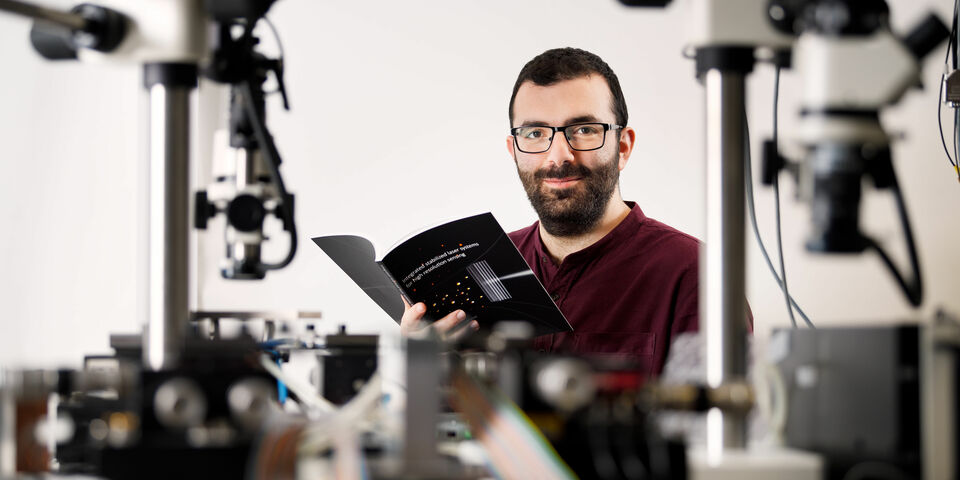Home Stretch | With atomic precision
To make faster computers, you need smaller chips. The Cyprus-born doctoral candidate Stefanos Andreou built a sensor with which deformations measuring less than the width of an atom can be measured. Chip machinery builder ASML may be able to use this technology to improve the precision of its machines.
Using ASML’s latest machines, computer chips can be produced whose details measure no more than a handful of nanometers. No mean achievement when you consider that a million nanometers fit into a single millimeter. The electric circuits on a chip like this are produced using lithography: a pattern is etched onto a slice of silicon with the help of ultraviolet light. As chip production requires the stacking of multiple patterns on top of one another, the positioning of the silicon slice (better known as a wafer) is a matter of great precision.
Even the slightest deformation of the wafers causes problems, explains doctoral candidate Stefanos Andreou. “These wafers are actually quite stiff, but because they are moved about at such great speed, they are subject to g-forces that slightly deform them. Measuring this deformation gives ASML the opportunity to compensate for it in some or other way, and opens up the possibility of producing even smaller chips.” This prompted the Cypriot to dedicate his PhD work to designing a special sensor, based on a glass fiber, capable of measuring these deformations of roughly one nanometer per meter.
Extraordinary accuracy
The idea behind this super accurate sensor is that deviations in the frequency of laser light can be measured with extraordinary accuracy - a principle that is applied in what is known as a Fiber Bragg Grating - a glass fiber of sorts treated in such a way that it becomes opaque for a very specific color (read: frequency) of light. This resonance frequency as it is called depends on the extent to which the fiber is stretched.
Consequently, a Fiber Bragg Grating (FBG), applied to the moving parts in the chip machine, can be used as a measure of the wafer’s deformation, explains Andreou. Assisted by master’s student Roel van der Zon, himself now a PhD candidate in Valencia, Andreou tested a measuring system based on this kind of FBG sensor in the lab. “In practice ASML would need dozens of these sensors, but that’s no problem: they can be produced cheaply and weigh almost nothing.”
The doctoral candidate is keen to point out that the precision they achieved of 5 nanometers per meter means that in the sensor itself - just a few centimeters in length - a deformation of a couple of dozen picometers can be measured. “That is less than the diameter of an atom!” Before this improbable level of accuracy could be achieved, however, a number of problems had to be solved.
Temperature
Firstly, sophisticated stabilization techniques were needed to ensure that the laser light used - generated by a photonic chip produced by Smart Photonics, a spin-off of the Photonic Integration research group where Andreou conducted his research - had exactly the right frequency. But perhaps the greatest challenge was the fact that the sensor’s resonance frequency is dependent on not only the deformation, but also the temperature. “That effect is actually much greater,” explains Andreou. “When the temperature changes by one thousandth of a degree Celsius, it causes a deviation in the measurement equivalent to ten nanometers of deformation per meter.”
To compensate for the inevitable temperature fluctuations, Andreou split the laser light used for the measurement into two components: “For each of these components, or polarization states, the fiber displays a different relationship between temperature and resonance frequency.” This cancels out the effect of the temperature, making it possible to determine the deformation very accurately. About ten times more accurately than used to be possible, according to the doctoral student. “And once the system is fully optimized, it should be possible to improve on that.”
But the Cypriot himself is no longer focused on this challenge; he now works as a postdoc at TU Delft. “ASML delivered some of the equipment used in my project and now a follow-up project with ASML is underway. So my work is being built on.”


Discussion